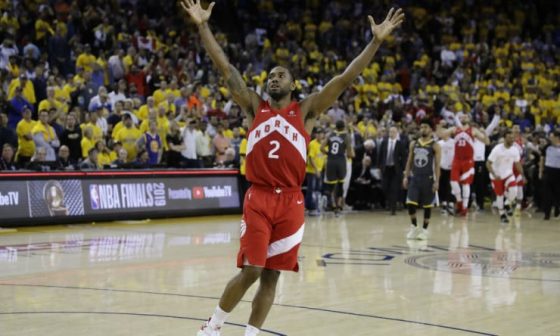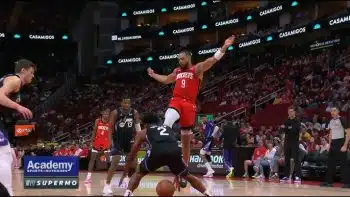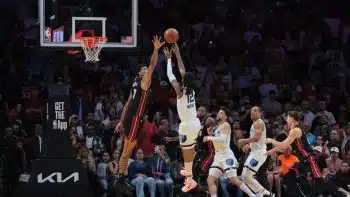NBA
NBA Daily: In Context: The Elam Ending & The 2019 NBA Finals

For all those bothered that Sunday’s All-Star Game ended on a free throw, let’s not remind them of the 2019 NBA Finals. Let’s not remember that — with less than a second remaining on the clock — Kawhi Leonard hit three free throws to turn a one-point lead into a four-point victory and a Toronto Raptors-winning championship.
Of course, if the “Elam Ending” had been in place for that Game 6, some different choices would have been made. That disclaimer aside, Leonard’s final free throw gave the Raptors what would likely have been the target score in that hypothetical. In fact, four of the six NBA Finals games ended on the likely target scores, anyway, while the other two never reached it.
Before walking through those scenarios, a quick description of the Elam Ending for those who did not follow Sunday’s exhibition: With a predetermined amount of time remaining, the clock is turned off; the game ends when a team reaches a “target score” established by adding a set number of points to the leading team’s score when the clock turns off. In the All-Star Game, the clock turned off for the entire fourth quarter, adding 24 points — a Kobe Bryant tribute — to the leading team’s score. For a more practical setting, it would be far less time and far fewer points.
Developed by a University of Dayton professor, Nick Elam, the well-named Elam Ending — which has been featured in the enormously-popular The Basketball Tournament over the last few years — adds eight points to the leading score at the first dead ball after the four-minute mark. If used in the NBA, Elam has suggested adding seven points at the last media timeout, coming at the first dead ball after the three-minute mark.
His rationale for seven stems from dividing typical full-game scoring rates by 16, but that fails to factor in late-game urgency and the inherent skewing to such a sample size. In short, the first three minutes will have less average scoring than the last three minutes simply because a bucket at the 2:59 mark is more likely than one a second into the game, not to mention a shot at 0:01 is more likely than one at 9:01.
Talked about this with Professor Elam and he made the point that starting the “ending” portion too early will wear everyone out, which is why his proposal is add 7 to high score at first stoppage under 3 minutes. https://t.co/GndXjOhyRz
— Anchorage Man (@SethPartnow) February 17, 2020
Thus, many have settled on eight — potentially another Kobe Bryant tribute — as the likely additional number if ever considered in the NBA. While the ending intends to remove any logic to intentionally fouling in late-game situations and thus preserving a truer state of the game we love, its effects go much further into strategy, lineup rotations and redefining the idea of “clutch.”
What it does not do, however, is shorten the game, at least in terms of points, as many incorrectly assume it does. Consider last year’s NBA Finals …
GAME 1: Raptors win, 118-109
First off, if we are to use the All-Star Game version of this drama-inducing ending, only two of the six Finals games would have reached the third quarter-dependent target score. Playoff games grind through the fourth quarter — but again, that was a gimmick for the exhibition contest. Any practical usage would have included a shorter ending.
The first dead ball after the three-minute mark in Game 1 came at the 2:35 mark with the Raptors leading 110-101, just after a Stephen Curry three-point play. Adding eight points to that 110 gives the final winning total, a number reached when Toronto guard Kyle Lowry hit a 28-foot three-pointer with 30 seconds left. At that point, it was essentially considered icing on the cake, turning a 115-106 lead into a 12-point margin — but in this theoretical, it would have been the game-winning shot.
Any 28-footer is dramatic, but that would have been quite the scene to start the Finals.
GAME 2: Warriors win, 109-104
The final minutes of this became a slog, so a more inspired conclusion would have been appreciated by all. A total of 3:18 passed between buckets from the 4:26 mark to the 1:08, keeping the score at 106-98 at the needed dead ball. Golden State added only an Andre Iguodala three-pointer with seven seconds remaining to stymie a Toronto charge that would’ve brought them within two. If the Warriors had needed to get to 114, it seems borderline-likely the Raptors would have pulled off the win and swept the series, considering that those were the only points Golden State scored in the final 5:39.
GAME 3: Raptors win, 123-109
Toronto led 115-103 at the last media timeout, while a Marc Gasol three made it 121-107 with 1:07 left before a Pascal Siakam layup reached the possible target score with a 14-point lead. Golden State was not coming back, so an Elam Ending would have at least expedited the ending. Jacob Evans may have been most appreciative of that as he missed two field-goal attempts after Siakam’s decisive points. Regardless, not much in the way of drama here.
GAME 4: Raptors win, 105-92
Again, it is hard to envision the Elam Ending changing much about this game — even with the inherent strategic shifts to it. Toronto led 99-89 with 2:48 left, but neither team exactly stressed in the final minutes. Curry turned a three-point play and the Raptors hit a trio of mid-range jumpers. Toronto did not reach the presumed 107 target score, but another mid-range shot from Siakam — who hit two of the aforementioned three — would not have taken long, and Golden State would not have rattled off 15 points before he hit it.
Both in real life and in this exercise, this blowout was the point in the series everyone began to realize what the Raptors really were about to do.
GAME 5: Raptors win, 106-105
As much as the Elam Ending was designed to eliminate an influx of free throws, it also puts an impetus on making shots. That might not sound revolutionary but, as often as not, games are determined by misses. Toronto led Game 5 by a score of 103-97 at the 2:59 mark when Draymond Green fouled Leonard. From that point on, the Raptors went 1-of-6 from the field.
Sure, Golden State hit a trio of three-pointers to take the lead and the game, while the Raptors struggled to get the ball anywhere near the hoop. But as impressive as the Warriors’ barrage was, wouldn’t everyone have preferred Curry or Klay Thompson to hit two more and break 111?
NBA, change the rules, make every fourth quarter like that fourth quarter…
— Bill Plaschke (@BillPlaschke) February 17, 2020
GAME 6: Raptors win, 114-110, and clinch the series
Here is where the Elam Ending would have provided a championship-worthy moment. In literal terms, Leonard’s three free throws with hardly any time remaining gave Toronto the 114 target score necessitated by a 106-101 lead at the 2:49 mark. For practicality, Golden State probably would not have melted down with back-to-back technical and personal fouls when they collectively realized a full-court, miracle three-pointer would be needed to win the game.
Instead, Iguodala would not have fouled Leonard at all — let alone earned the technical. The Raptors would have clung to a one-point lead, needing just three more to win the title.
The Elam Ending does not bring about the end of the game any faster in basketball terms — in real-time, though, the dearth of fouls unquestionably speeds things up — but it largely brings the dramatic moments we remember.
Of course, Anthony Davis’ clinching free throw was not all that abnormal.
Still, in the context of a recently-thrilling NBA Finals, it’s easy to see why the Elam Ending has people hyped to talk about basketball nuances again — naturally, however, it does not guarantee drama.











